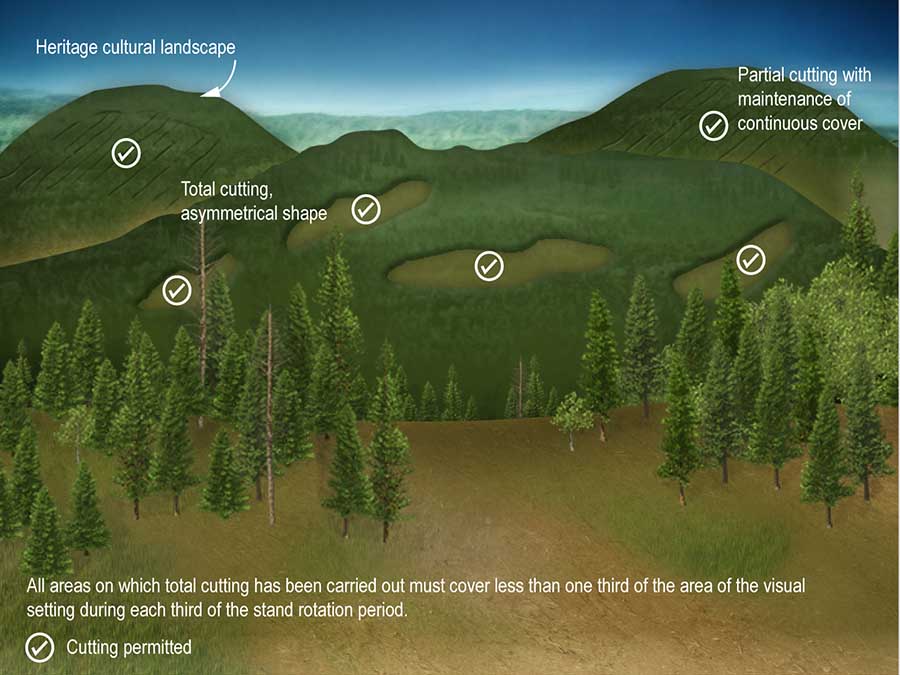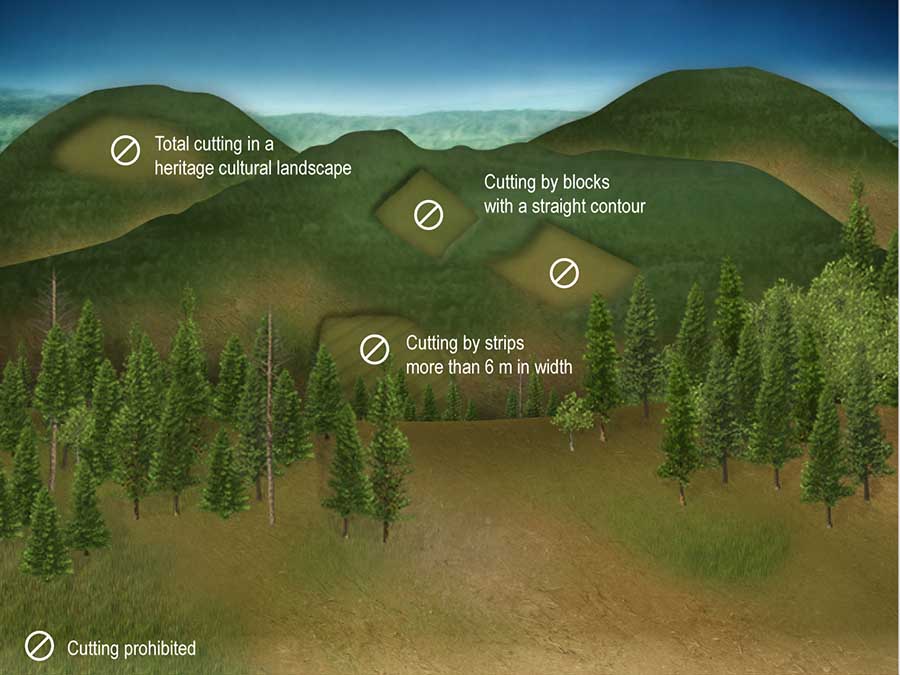Chapter II – Protection of particular places and territories
Division I – General
§3 – Visual setting
Section 14
Partial cutting with maintenance of a continuous forest cover is allowed throughout the visual setting or in a heritage cultural landscape. Partial cutting without maintenance of a continuous forest cover is prohibited. 
1
Objectives
- To maintain landscape quality
- To allow for the harvesting of wood
- To reconcile forest development activities with the protection of the cultural heritage
Additional information
The following guide (in French only) contains good landscape quality maintenance practices:
Stratégie d’aménagement pour l’intégration visuelle des coupes dans les paysages 
The Government may designate a heritage cultural landscape by order-in-council. The designation is then entered in the Cultural Heritage Register, the data from which appears in the Répertoire du patrimoine culturel du Québec (Directory of Cultural Heritage).
Figure 14 A Cuts permitted in a visual setting or heritage cultural landscape
Figure 14B Cuts prohibited in a visual setting or heritage cultural landscape
Total cutting is also allowed in a visual setting, except total cutting with a harvest pattern by harvest strips more than 6 m in width or by blocks with a straight contour. However, all the areas where the allowed total cutting is carried out must cover at least the third of the area of the visual setting during each third of the expected period of rotation of the stands, in order to preserve at all times the quality of the landscape. 
2
Objectives
- To maintain landscape quality
- To allow for the harvesting of wood
Additional information
All the areas where total cutting is carried out must cover less than one-third of the area of the visual setting during each third of the expected period of rotation of the stands. The period of rotation is the same as that used to calculate the allowable cuts. For example, if the prescribed period of rotation is 75 years, total cutting can be carried out in less than one-third of the area of the visual setting every 25 years.
The following guide (in French only) contains good landscape quality maintenance practices: Stratégie d’aménagement pour l’intégration visuelle des coupes dans les paysages 
A forest strip may provide a visual screen as an obstacle to a site requiring visual setting. In cases where a strip would be used as an obstacle, a request for an exemption to the Regulation under section 40 of the Sustainable Forest Development Act must be filed with the management unit in charge  (in French). However, the following conditions must be met:
(in French). However, the following conditions must be met:
- The strip should be widened to a minimum of 60 m depth.
- No partial cuts can be made.
- It must be maintained until the cutover areas have a forest cover at least 4 m tall.
Figure 14 A Cuts permitted in a visual setting or heritage cultural landscape
Figure 14B Cuts prohibited in a visual setting or heritage cultural landscape
Total cutting is prohibited in a heritage cultural landscape designated by the Government under the Cultural Heritage Act  (chapter P-9.002).
(chapter P-9.002).
3
Objective
- To maintain landscape quality
Additional information
The Government may designate a heritage cultural landscape by order-in-council. The designation is then entered in the Cultural Heritage Register, the data for which appears in the Répertoire du patrimoine culturel du Québec  (Directory of Cultural Heritage) (in French only).
(Directory of Cultural Heritage) (in French only).
Figure 14B Cuts prohibited in a visual setting or heritage cultural landscape
This section does not apply to the holder of a forestry permit issued for public utility works. 
4
Objective
- To allow certain forest development activities in or near a particular place
Explanations
A person who holds a forestry permit can carry out the forest development activities required for public utility works without applying the standards set out in this section for heritage cultural landscapes and the visual settings of the places and territories listed in sections 12 and 13.
The Minister responsible for applying the Sustainable Forest Development Act  specifies which forest development activities are authorized in the forestry permit and sets the conditions to be met when they are carried out.
specifies which forest development activities are authorized in the forestry permit and sets the conditions to be met when they are carried out.
Additional information
The Sustainable Forest Development Act  states that a forestry permit is required to carry out certain forest development activities in forests in the domain of the State (section 73). The Act allows the Minister to issue a permit authorizing the holder to carry out the forest development activities specified on the permit, on the conditions determined by the Minister (section 74).
states that a forestry permit is required to carry out certain forest development activities in forests in the domain of the State (section 73). The Act allows the Minister to issue a permit authorizing the holder to carry out the forest development activities specified on the permit, on the conditions determined by the Minister (section 74).



